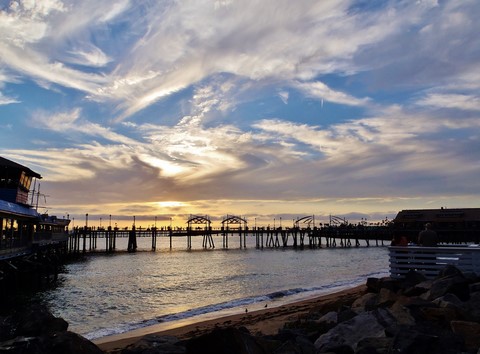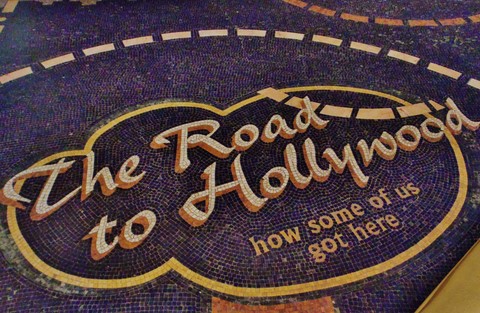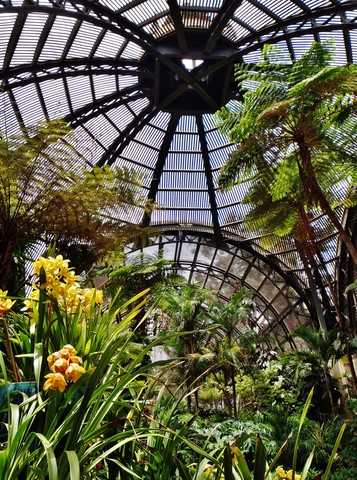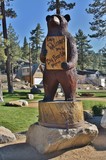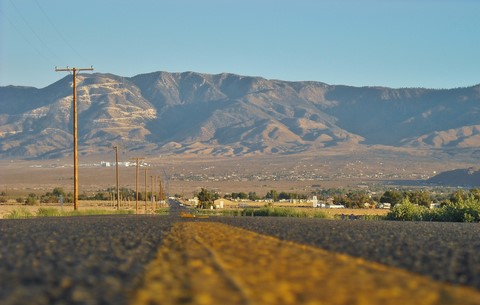California
You can click on pictures to enlarge them
Los Angeles - «Beach Cities»
That very pleasant coastal town is where we started that extraordinary trip: we stayed there during our two days in Los Angeles, and we had breakfast at Ruby's Diner, which 50's, 60's nostalgic charm and period decoration appealed to us, reminding us many movies scenes.
However, we have been enchanted and pleasantly surprised by Venice Canals, district located close to the seafront, with a very typical charm. There, canals overhung by small bridges are surrounded by residences with great character, as well as the gardens surrounding them, little extended but with very rich and varied vegetation and decoration. Opposed architectural styles meet without running out of harmony. Some of the houses are modest, others are disproportionate. Both near and far from the hustle and bustle of the seafront, there is undeniably an aura of sweetness of life about that place. We were totally unaware of that little-publicized side of Venice Beach, which we discovered incidentally, and it really appealed to us.
Los Angeles - Hollywood
That is why we stayed late there: to immerse ourselves in that extraordinary atmosphere before we join the madness and the hugeness of Hollywood Boulevard (photo). It almost looked like a rude awakening as the contrast was striking. We decided to make just a short stop to stroll a few minutes on the must-see Walk of Fame, for we were not particularly attracted to the flashy and maybe superficial side of that place. But against all odds, we were caught by the crazy atmosphere that reigned over there, and we stayed for the evening. Everything is just excess, and the area is much more attractive at night, when it gets filled with many-colored lights as far as the eye can see. We were like amazed and dazzled children, swept along by the crowd and the fervor.
Finally, we spent one of the best nights of our trip, and one of the most funny as well.
Orange County - «Beach Cities»
San Diego
More secure and less polluted than Los Angeles, life there is also less expensive. It is famous for its big amusement parks with family tradition, but it has much more to offer. It abounds in riches. Many museums add to historical sites, which gives it an undeniable cultural interest. Its parks and its beaches compete in beauty. Located a few kilometers from the border, it has always maintained its important Mexican heritage.
The climate there is very pleasant: globally much sunny and mild, it is rarely raining. However, the weather can sometimes be patchy on the seafront, when a sudden mist drapes beaches with its thick and persistent grayness, and brings moreover a little bit of coolness. But it ends up clearing in the middle of the day.
In the City Center, Downtown, Embarcadero and Little Italy districts were in the beginning the seamen quarter that was damaged, and then has been restored. The Manchester Grand Hyatt building rises on the bay, very modern with a little touch of Victorian style. A nice promenade runs along the Embarcadero Marina Park. It has many pontoons. There, you can admire nice yachts. The nautical theme is recurring in the district’s modern architecture: the San Diego Marriot Marquis & Marina depicts two boats that return to port if you observe it through a given angle. As for the San Diego Convention Center, its outline reminds a liner. You have understood; San Diego is primarily a city with harbor tradition: in front of the Maritime Museum, you can see magnificent sailboats moored to quays. Cruise ships draw alongside the Broadway Pier, as well as the ferry to Coronado Island. The USS Midway Museum allows you to visit the famous World War II aircraft carrier.
Gaslamp became the artists' haven. There are notably restaurants and cafes that attract crowds of people along Broadway. Art galleries, theaters, museums and shops are not forgotten. We have been there a Thursday night and the atmosphere was going full swing, with many students. Buildings and streetlights - which gave the district its name - from the 19th century mix with modern buildings and give the place a certain authenticity and a historical value. A modern architecture that is sometimes daring and innovative mixes with older styles like Victorian or Far-West, which forms a very eclectic set.
We mostly visited Balboa Park, a must-see: it is a huge exotic park overlooking the ocean. It groups together very varied museums, theaters, gardens (including the beautiful Japanese Garden), a golf course, cycle lanes, picnic and hiking areas, and especially the famous zoo: it is unique in the world with more than 3200 animals, its tropical and subtropical areas, its exceptional scenery and environment made to recreate the occupants’ original environment. Unfortunately, we could not visit it because we had a long drive. On the other hand, we had time to admire the Botanical Garden, as varied as abundant. It has many tropical plants, including carnivorous plants. It is housed by the Botanical Building (photo): made of wooden slats, that one is really beautiful with its curved lines. The Spreckels Organ Pavilion enjoys a refined architecture. The very imposing organ it houses under its vault is a true wonder. You can see from the distance the harmonious outline of the California Tower, which proudly overlooks a sumptuous architectural ensemble in Hispanic Colonial style.
Coronado Island is a superb peninsula you can get to from the city center on the ferry or by road driving across the impressive San Diego-Coronado Bridge, opened in 1969. It is linked to the continent by an 11 kilometers isthmus: the Silver Strand. It is mainly residential and superb modern villas are near sumptuous Victorian houses. According to many people, Coronado Central Beach is one of the most beautiful beaches in the U.S.A. Its Southern part is more attractive: indeed, when the tide goes out, it lets resurface the Monte Carlo shipwreck - that ran aground in the 1930’s - like a ghost from the past. But above it all, it is where the sumptuous Hotel Del Coronado - in an extravagant Victorian style - majestically rises. Its immaculate façades and its red roofs - especially the one of the Crown Room, with an octagonal shape - are well known all around the world. It is a real jewel of architecture that we visited a long time. The reception hall is just fabulous. It is mainly made of varnished oak wood. Its ceiling, its columns and its interior balconies will leave you speechless. Its terrace offers a breathtaking view of the ocean. It was the first in the world to install electric illumination. It was made famous in 1959 thanks to the movie «Some like it hot» with Tony Curtis, Jack Lemon and the unforgettable Marilyn Monroe. Yet, the part of the movie which concerns the Hotel Del Coronado takes place… in Florida!!?
Facing Coronado Island, Point Loma, superb peninsula covered with cliffs, has two major assets. First, there is Whale Overlook, a perfect spot for whale-watching. However, it is limited to the winter period. The other attraction is the beautiful Cabrillo National Monument, located on the highest point of the peninsula. One might as well say that it offers an unrestricted panoramic view. It was named after the explorer who discovered the San Diego Bay in the 16th century. A four meters high statue of him proudly rises there. Nearby stands the Fort Rosecrans National Cemetery, very wide military cemetery which white graves line in a perfect grid on impeccable red lawns. Old Point Loma Lighthouse is one of the oldest lighthouses in California, built in the mid 19th century. It closed decades ago but you can visit it, especially since it is very well preserved. Finally, the Sunset Cliffs spot is much appreciated by surfers.
Old Town has a considerable historical significance. And for good reason: there are quite simply the first European facilities in California. They date from 1769, even though the site was discovered by the Spanish nearly in the mid 16th century. However, it only prospered during one century, when they decided to move the core of the city to the bay. Shortly after, a fire sealed the fate of Old Town. But they started to restore it from the late 1960's, conscious of its inestimable value. The Old Town San Diego State Historic Park recounts its history. Most of buildings are made from adobes that surround a garden. Presidio Park includes the very first of the 21 missions built in California: the Mission San Diego de Alcalá. Heritage Park is a site composed of restored houses and cottages in Victorian style.
La Jolla is a very charming small opulent seaside resort that includes among others the University of California San Diego and the Torrey Pines golf course. It is home to many different architectural styles. The atmosphere there is very pleasant. The Torrey Pines State Natural Reserve offers much appreciated trails. The entrance is free but parking is expensive. However, there are some free parking lots outside the site… for the first come or the luckiest… Various viewpoints offer breathtaking panoramas. The same can be said about the one in Mount Soledad, a little further south. It is a monument dedicated to military casualties fallen in battle during the various contemporary wars in which the Commonwealth participated. Perched on the top of a hill, it is surmounted by a big white Latin cross. The beautiful La Jolla Cove is notably famous for its superb sunsets. Much photogenic, it is one of the nicest beaches in Southern California. Seals, eared seals, sea lions and pelicans do the show and contribute to the friendly atmosphere of the place. Leopard sharks sometimes invite themselves, but they are harmless to humans.
The San Bernardino Mountains
We stopped at Big Bear Lake (photo), superb lake nestling in a green setting, including islets, located 2100 meters above sea level. It is an idyllic place where some beautiful chalets and small wooden pontoons surrounded by boats are dotted along the shore.
The Mojave Desert
We broach it in this chapter in order to mention its part located beyond the San Bernardino Mountains, in the direction of Northern Arizona and Southern Nevada, which we crossed to join Laughlin, Nevada.
When we drove away from Big Bear Lake and the surroundings, we left behind for good the part of our trip lulled by the mildness of the Southern-California coast and its idyllic hinterland, to throw ourselves wholeheartedly in the crossing of arid or semiarid areas, of national parks out of the world and out of time, with a breathtaking hugeness. Indeed, there is no geographical transition between both: the change between the relative coolness in the San Bernardino Mountains landscapes filled with greenery and the overwhelming heat in the Mojave Desert’s lands of desolation is sudden. Terribly sudden… Terrifically sudden…
We first beheld it from a distant viewpoint in the mountains. Ghostly zone shrouded in a deep heat mist, we could only see some blurred outlines and an amazing ocher color which seemed to loom up from nowhere, for we had been accustomed to the bright greenery in landscapes made of lakes and mountains. Our imagination did the rest, as well as reminiscences from westerns and road-movies which carried us away and made us want to visit that wide region in the New Continent. We were torn between our impatience to join that amazing desert and give ourselves up to it, and the will to go on enjoying an unrestricted view of that entrancing and surrealist landscape.
When we finally entered it, we could not resist making a stop. The afternoon was nearing its end. Everything seemed dead and still in the deep heat. However, the spot was bathed in changing and full of life colors. It is mainly that strange paradox which makes it a place out of the ordinary.
In the distance, the road was boiling in the ruthless furnace, in a mist with moving and changing shapes. In our wildest dreams, we could see John Wayne on his faithful horse appear suddenly, or Thelma and Louise in their convertible Thunderbird with their hair in the wind, eating up miles, enjoying their one way trip both dramatic and romantic which bound them forever.
Then we launched into a series of imitations of cinema heroes who crossed that desert, punctuated with bursts of laughter and comical photographic sessions. Sometimes on the contrary, we did not say a word to immerse ourselves in that incredibly deep silence. That place touched us and inspired us in various ways.
Finally, we got back into our car to carry on driving. Then, that new adventure could begin.
We were ready to explore the mythical and breathtaking Western America national parks. But maybe we already were from the moment we dismounted on the Los Angeles International Airport ground with a light heart and a head full of dreams… Or a few weeks before when we finally had our plane tickets in our hands, symbols of that terrific imminent journey…
Or maybe years ago, from the time that crazy dream began to form in our minds…
Published on August 13th 2013



